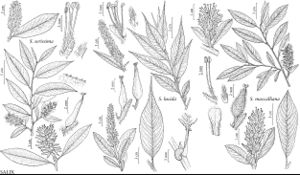Salix exigua
N. Amer. Sylv. 1: 75. 1842.
Shrubs or trees, 0.5–5 (–17) m. Stems: branches gray-brown, redbrown, or yellowbrown, villous, or tomentose to glabrescent; branchlets yellowish, yellowbrown, or redbrown, pubescent or puberulent, tomentose, short or long-silky-villous. Leaves: stipules absent or rudimentary on early ones, foliaceous or rudimentary on late ones; petiole 1–5 (–10) mm, pubescent or puberulent, villous, or short-silky adaxially; largest medial blade (sometimes hypostomatous), linear or lorate, (glands marginal), 30–136–143 × 2–14 mm, 6.5–28 (–37.5) times as long as wide, base cuneate, margins slightly revolute, entire or remotely spinulose-serrulate, apex acuminate or acute, abaxial surface glaucous (sometimes obscured by hairs), densely long-silky, villous or pilose to glabrescent, hairs appressed or spreading, straight or wavy, adaxial slightly glossy, sparsely or densely long-silky to glabrescent; proximal blade margins entire; juvenile blade yellowish green, densely long-silky-villous abaxially. Catkins: staminate 7–54 × 2–10 mm, flowering branchlet 1.5–56 mm; pistillate loosely to densely flowered, slender or stout, 14.5–70 × 3–12 mm, flowering branchlet 2–55 mm; floral bract 1.2–2.6 mm, apex acute, convex, or rounded, entire or erose, hairs wavy, straight, or crinkled, abaxially hairy throughout or proximally, or glabrate. Staminate flowers: abaxial and adaxial nectaries present and distinct; filaments hairy on proximal 1/2; anthers (sometimes reddish turning yellow). Pistillate flowers: adaxial nectary oblong, ovate, or flask-shaped, relative adaxial nectary/stipe length variable even within same catkin; stipe 0–0.9 mm; ovary obclavate or pyriform, glabrous, pilose, or villous, or sometimes beak hairy, beak bulged below or abruptly tapering to styles; ovules 12–30 per ovary; styles (sometimes distinct), 0–0.5 mm; stigmas flat, abaxially non-papillate with rounded tip, or 2 plump lobes, 0.1–0.5 mm. Capsules 4–8 mm. 2n = 38.
Distribution

Alta., B.C., Ariz., Calif., Colo., Idaho, Mont., N.Mex., Nebr., Nev., Okla., Oreg., Tex., Utah, Wash., Wyo.
Discussion
Varieties 2 (2 in the flora).
Selected References
None.
Lower Taxa
Key
| 1 | Branchlets densely short-silky-tomentose or short-silky-villous; juvenile blades densely long-silky abaxially, hairs usually appressed, sometimes a few spreading; stipes 0.2-0.9 mm; styles connate, 0-0.2 mm; ovaries usually glabrous, sometimes beak hairy; stigmas flat, abaxially non-papillate with rounded tip, or 2 plump lobes. | Salix exigua var. exigua |
| 1 | Branchlets pubescent or densely long-silky-villous; juvenile blades densely long-silky-villous abaxially, hairs spreading, appressed; stipes 0-0.2 mm; styles connate or ± distinct, 0.1-0.5 mm; ovaries pilose or villous to glabrescent; stigmas flat, abaxially non-papillate with pointed tip, or slenderly cylindrical. | Salix exigua var. hindsiana |
"-143mm" is not declared as a valid unit of measurement for this property.
